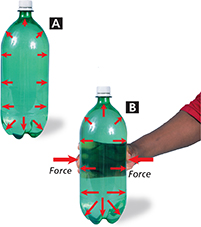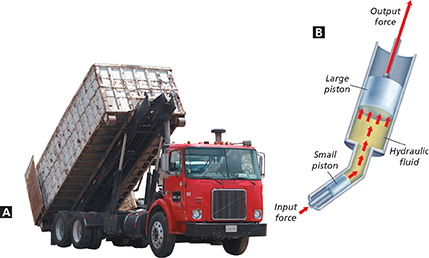Pascal's Principle
The pressure forces acting on the bottle are shown in Figure 6A. Note that at any given depth, equal pressures act against the inside of the bottle. Note also that the pressure increases with depth. Now imagine what happens to the pressure inside the bottle if you tightly squeeze it at the middle. Will the pressure be greater at the point where you squeeze?
The pressure inside the squeezed bottle is shown in Figure 6B. Note that the pressure increases with depth, as it did before the bottle was squeezed. More important, note that the pressure increases equally throughout the water, not just at the point where you squeeze. Pascal discovered this phenomenon in the 1600s. His observation led to a general principle.  According to Pascal's principle, a change in pressure at any point in a fluid is transmitted equally and unchanged in all directions throughout the fluid.
According to Pascal's principle, a change in pressure at any point in a fluid is transmitted equally and unchanged in all directions throughout the fluid.
Figure 6 A change in pressure at any point in a fluid is transmitted equally and unchanged in all directions throughout the fluid. A Note that the forces exerted against the walls of the container are equal at a given depth. B When squeezed, the pressure is transmitted equally throughout the fluid.

Hydraulic Systems
Hydraulics is the science of applying Pascal's principle. The dump truck in Figure 7A makes use of a hydraulic lift system. A hydraulic system is a device that uses pressurized fluid acting on pistons of different sizes to change a force.
Look at the diagram of a hydraulic system shown in Figure 7B. An input force is applied to the small piston, which pushes against the fluid sealed in the hydraulic system. Applying Pascal's principle, you know that the pressure produced by the small piston is transmitted through the fluid to the large piston. Thus, the pressure on both pistons is the same.
However, the pressure pushing against the large piston acts on a much larger area, which is the key to how the system works.  In a hydraulic lift system, an increased output force is produced because a constant fluid pressure is exerted on the larger area of the output piston. This large output force is used to lift and dump the load. The amount the input force is increased depends on the areas of the pistons. If the large piston has eight times the area of the small piston, then the output force is eight times greater than the input force. Why is this? Recall that force is equal to the product of pressure and area. Because the pressure on each piston is the same, the difference in forces is directly related to the difference in areas.
In a hydraulic lift system, an increased output force is produced because a constant fluid pressure is exerted on the larger area of the output piston. This large output force is used to lift and dump the load. The amount the input force is increased depends on the areas of the pistons. If the large piston has eight times the area of the small piston, then the output force is eight times greater than the input force. Why is this? Recall that force is equal to the product of pressure and area. Because the pressure on each piston is the same, the difference in forces is directly related to the difference in areas.
Figure 7 A The truck uses hydraulic-powered struts to lift its load and dump it on the ground. B The larger area of the output piston produces the increased force used to lift the load.
 d
d



